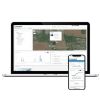NexSens X2 Environmental Data Loggers
Features
- Cellular and Iridium satellite telemetry options
- Marine anodized aluminum housing for deployment in harsh environments
- WQData LIVE web datacenter for instant data access from any web browser
- Expedited repair and warranty service
- Lifetime technical support
- More
The X2 is an all-in-one environmental data logger that can be controlled from any internet browser using a smartphone, tablet, or PC. It automatically recognizes sensors and sends data to the web via cellular or Iridium satellite telemetry. The X2 includes three sensor ports that are compatible with most environmental sensor protocols including SDI-12, RS-232, and RS-485. All connections are made with a simple thread-in connector, and the built-in sensor library automatically facilitates setup and configuration. Data is stored on common or independent schedules.
Power options include SP-Series solar packs, AC adapter, or external 5-16 VDC. Advanced power management combined with ultra-low sleep and run currents extend battery life and eliminate the need for multi-battery arrays or large solar charging systems. Smart power circuits automatically switch to reserve power when the main source is depleted. The X2 monitors itself while collecting environmental data. Internal temperature, humidity, voltages and currents are constantly recorded. Failure alerts can be sent automatically to a predefined list of contacts.
Using a USB adapter and CONNECT Software, users can configure the X2 data logger for deployment, view live data, change settings, or troubleshoot. Optional integrated cellular or Iridium satellite telemetry modules offer real-time remote communications via the WQData LIVE web datacenter. There, data is presented on a fully-featured and easy-to-use dashboard. Other features include automated reports, alarms, push notifications and much more.
Mount: (3) 3/8-16 bolt holes on bottom
Material: Anodized aluminum
Weight: 3.5 lbs.
Dimensions: 4.9" Diameter, 4.77" Height
Power Requirements: 5-16 VDC +/-5% (Reverse polarity protected)
Current Draw (Typical @ 12VDC): Low power sleep: 350uA; Active: 45mA; Cellular Transmitting: 300mA; Iridium satellite transmitting: 170mA
Peak Current: Power supply must be able to sustain a 500mA 1-second peak current (@ 12V)
Operating Temperature: -20C to 70°C
Rating: IP67 (Standalone); IP65 (With telemetry)
User Interface: RS-485 direct to CONNECT Software, WQDatalive Web Datacenter, Status LEDs
Data Logging: 256MB microSD card (expandable up to 4GB)
Data Processing: Parameter level polynomial equation adjustment; Basic & Burst Averaging (min, max, standard deviation, and raw data available)
Real Time Clock (RTC): <30sec/month drift1; Auto-sync weekly2; Internal backup battery
Log Interval: User configurable from 1 minute (10 minute default)3; Unique interval per sensor
Transmission Trigger: Time-based; Selective parameter upload option
Sensor Interfaces: SDI-12, RS-232 (3 Channels), RS485
Sensor Power: (3) independent switches from input supply4,5
Built-in Sensors: Temperature (-40 to 85C, 0.1C resolution, ±0.3C accuracy); Humidity (0% to 100%, 0.1% resolution, ±4% accuracy from 5 to 95% RH & -20 to 70C); Battery voltage; System & sensor current
Sensor Ports: (3) 8-Pin for Sensor Interface (RS-232, RS-485, SDI-12, Switched Power, GND)
Power Port: (1) 6-Pin for Power and Communication (Primary/Secondary/Backup Input, RS-485 Host, GND)
Telemetry Options: 4G LTE cellular, CAT-M1 cellular, Iridium satellite
Antenna Port: SMA
Notes
1Assumes 25ºC operating temperature
2Requires the X2 to be connected to the internet
3Minimum log interval dependent on sensor limitations and processing time
4Cumulative concurrent current limit of all three channels is 2A
5Logger power supply must be able to support current requirements of sensors
- (1) X2 environmental data logger
- (3) Sensor port plugs
- (1) Power port plug
- (1) Magnetic screwdriver
- (1) Quick start guide
- (1) Wireless antenna (telemetry units only)
In The News
Susquehanna River Basin Commission: Cloud Data and Water Quality Monitoring
As technology becomes more closely interwoven with water quality monitoring, some organizations have found themselves forced to catch up, but not the Susquehanna River Basin Commission (SRBC) . The SRBC has had a long-standing relationship with remote data collection. With the establishment of their Early Warning System (EWS) in 2003 and their Remote Water Quality Monitoring Network (RWQMN) in 2010, the commission has shown clear dedication to water quality monitoring. Background and History of the Continuous Instream Monitoring System The EWS and RWQMN merged to become the Continuous Instream Monitoring system . Environmental scientist Dawn Hintz shares, “The original intent of the RWQMN was completely related to natural gas, to the unconventional natural gas industry.
Read MoreNew Environmental Sensors and Data Acquisition Knowledge Base
NexSens Technology has worked for over two decades to simplify complex environmental data acquisition systems. The core components of these systems have always been the development of data loggers, configuration and data management software, and simplified sensor integrations. NexSens is excited to bring a new dimension to another critical aspect of real-time environmental monitoring: environmental sensors and data acquisition documentation through the revamped online Knowledge Base. The Knowledge Base serves as a living library, featuring the most thorough information, start-up instructions, integration guides, and other documentation available for NexSens systems and products.
Read MoreWireless Mesh Environmental Sensing Network System Tested
For scientists working in the field, monitoring for data isn't enough—you have to get that data back. This is of course true, no matter how sophisticated a real-time monitoring solution is. Recent testing of a wireless mesh environmental sensing network at Virginia Tech reveals a promising new option for this kind of problem, and Innovative Wireless Technolog ies (IWT) principal investigator Matthew Fisher spoke to EM about the testing and the network: Envōk . Solving data transmission difficulties wirelessly Since 1997, Innovative Wireless Technologies has been developing wireless products that use 900 megahertz radios in mesh networking technologies.
Read More

























